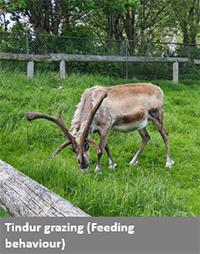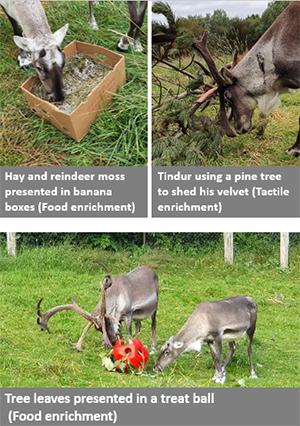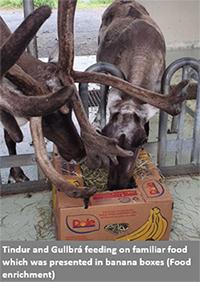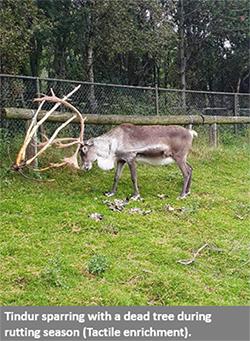Discussion
Baseline period vs. enrichment period

During the baseline period, the reindeer spent more than half of their time being inactive. However, during the enrichment period, the reindeer became significantly more active. Their level of activity and inactivity during the enrichment period is consistent with what other studies have shown on captive and wild reindeer.
The reindeers' activity pattern also changed during the enrichment period. Their activity pattern consisted more of consecutive series of foraging and ruminating, which is similar to the activity pattern wild reindeer have.
Comparison of the enrichments

Food enrichment
Previous studies done on reindeer show that they spend a lot of their time grazing and feeding throughout the day, which could explain why all four reindeer were always so eager to interact with food enrichment when presented.
These reindeer showed the most interest in tree leaves, and least interest in pine trees. Reindeer are known to graze on evergreens, therefore it was unexpected that these reindeer showed so little interest in consuming pine trees. This could be due to the fact that they do not have access to pine trees, but they have been seen to climb the fence and jump to get to trees bearing leaves, and during the autumn they do have access to tree leaves that fall from the trees surrounding their enclosure.
Olfactory enrichment
Olfactory enrichment was the least interesting enrichment for these reindeer. Reindeer have a sensitive sense of smell, therefore it was expected that they would spend more time interacting with this enrichment. This could be due to the selection of odours, how they were presented, or because of neophobia. However, a study done on feedlot cattle found similar results in regard to lack of interest in olfactory enrichment.
Tactile enrichment
Both captive and wild reindeer utilize dead trees and logs to get rid of their winter fur and their velvet and other ungulate species have shown interest towards different types of tactile enrichment, therefore it was expected that tactile enrichment would be favoured by the reindeer, however, that was not the case in this study.
Monthly comparison

The reindeer were the least active in June, which was expected since the enrichment period started in June and the reindeer were a bit sceptic at first of everything that was presented to them. From July on, they became more active and this trend continued by the month. This shows that with time the reindeer became perhaps less afraid of exploring the enrichments, which may be an indicator of neophobia.
The reindeer were most active in September, which can be explained by the start of rutting season. During the rutting season, the reindeer became more active due to the fact that the male was running after the females and herding them together. This is consistent with what happens in the wild and therefore this behaviour was expected.
Comparison between individual reindeer

All four reindeer in this study followed a similar pattern. Their activity patterns, throughout the study, were consistent and did not differ remarkably. A study done on red deer showed that when in smaller herds, they synchronize their activity to those nearest them. A similar study done on small herds of cattle found the same. This may explain the similar activity patterns of these reindeer, since there are only four reindeer in this herd.
The difference that was found in the average proportion of activity between the reindeer could be due to social rank among the herd. Because Tindur yielded the highest proportion of activity in most instances, this suggests that he is the highest-ranking reindeer in the herd.
There were also instances of Regina displaying hostile behaviour towards Hallveig and Gullbrá. She and Tindur would them away from food enrichment so they could have most of it for themselves, which could mean that Regina is the second-highest ranking reindeer.
Responsible for this page:
Director of undergraduate studies Biology
Last updated:
05/27/21
